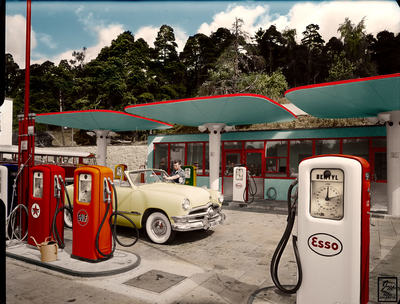Why Gas Mileage Improves in the Summer
There are significant environmental benefits to summer-blend fuel, as well as increased fuel efficiency
ALEXANDRIA, VA - June 29, 2018: The annual spring transition to produce, transport, store and sell these fuels is one of the reasons that gas prices have increased an average of 53 cents per gallon each spring since 2000, when the Clean Air Act Amendments required that summer-blend fuels be sold in many areas of the country. Since 2000, many other areas have opted in to the program, and summer-blend fuels now are used in 18 states—largely those with more densely populated communities.
Summer-blend fuels evaporate less readily, so they are less likely to lead to the formation of smog in the warmer months. The downside is they’re more expensive to produce, and the transition puts enormous upward pressure on prices across the country as refineries are retooled while demand increases.
While the pain of this transition to summer-blend fuel is felt throughout the United States, there are significant environmental benefits. And there’s another key advantage for drivers: increased fuel efficiency. Part of the reason for the improved mileage is the makeup of the fuel itself, but weather-related factors also play a big role.
Regardless of where consumers fill up in the United States, they often will enjoy better fuel efficiency in the summer months. The level of fuel efficiency will depend upon fuel specifications required in certain regions, as well as weather-related factors.
More Efficient Burn
In the summer months, roughly one-third of the country requires fuels that have a reduced Reid vapor pressure (RVP). RVP measures volatility of a fuel in terms of pounds per square inch (psi); the lower the RVP of a fuel, the
less likely it is to evaporate. Normal atmospheric pressure is 14.7 psi. Anything above that threshold will become a gas, and the closer a fuel is to that level, the more likely it is to evaporate. Summer-blend fuels typically
have much lower RVPs—typically around 7 to 9.
In the colder months, less thermal energy in the air makes evaporation, also called “vapor lock,” less of an issue. In fact, evaporation can be helpful in the colder months. Vehicles don’t start as easily in colder temperatures, so it is helpful to add components to make fuels evaporate. After all, engines don’t run on gas; they run on gas vapors.
That’s where butane fits in to the mix, literally. Gasoline is a complex combination of dozens of different blends including butane, which is plentiful and relatively inexpensive compared to other fuels. Butane, with an RVP of 52, also evaporates very easily. In the winter, the percentage of butane in gasoline is increased, which decreases the cost of the gasoline and increases the overall RVP. Overall mixes vary, but summer-blend gasoline with a low RVP may only have 2% butane, while higher RVP winter-blend fuels may contain up to 10% butane.
Generally, a higher RVP leads to a decrease in fuel efficiency. Butane provides less energy than other fuels, as measured by British thermal units (BTUs). Summer-blend gasoline contains less butane than regular gasoline, so it delivers more energy per gallon.
The Environmental Protection Agency (EPA) reports that summer-blend fuel delivers about 114,500 BTUs per gallon, as opposed to 112,500 BTUs for conventional blend, which translates into 1.8% better fuel efficiency. However, some summer-blend gasoline may contain as much as 117,000 BTUs, while winter-blend gasoline may contain as few as 108,500 BTUs—in some circumstances, summer-blend fuel could be up to 7.8% more efficient than winter-blend fuel.
Weather Plays a Key Role
Summer-blend fuel will slightly improve fuel efficiency, but drivers across the United States, including areas that don’t require summer-blend fuel, report that their miles per gallon often see big improvements in the summer months.
How is that possible?
A number of factors, all weather related, can increase fuel efficiency by as much as 10% during the summer months, regardless of the type of fuel purchased:
• Engines are more efficient: In the colder months, it can take longer to start a car and multiple cranks of the engine waste fuel. In addition, many drivers give their cars a chance warm up, whether to defrost windows or heat the interior. This idling detracts from fuel efficiency. But even without this idling, car engines are less efficient when cold. It may take a while for a cold engine to achieve peak efficiency and on extremely cold days it may never achieve peak efficiency. Overall, engines perform much better when outside temperatures are 90 degrees, not 20 degrees.
• Ice and snow detract from mileage: Ice and snow can hurt mileage, whether on the roads or on a vehicle. Cars are likely to spin their wheels under icy conditions, reducing efficiency. Also, drivers tend to travel at slow, less fuel-efficient speeds under poor road conditions brought on by extreme winter weather. In addition, any snow or ice on a vehicle adds weight and makes the vehicle less aerodynamic, as does any weather-related grime on the vehicle. One more thing: Hot air is less dense than cold air. All things being equal, a vehicle is more aerodynamic travelling through hot air. Of course, that factor may be negated by higher humidity.
• Better tire pressure: Tires lose air pressure in colder temperatures. If a tire’s air pressure isn’t adjusted in the colder months, it will be flatter and increase resistance and friction, leading to reduced fuel efficiency. The opposite occurs in the warmer months, and fuel efficiency can increase.
• Lubricants perform better: A car’s oil is more viscous (thinner) when it is warm and engines perform more efficiently when oil is thinner. The same holds true for all other lubricants. In addition, people take better care of their vehicles when it is warmer outside. They are more likely to change the oil and conduct other routine maintenance that can improve fuel efficiency.



